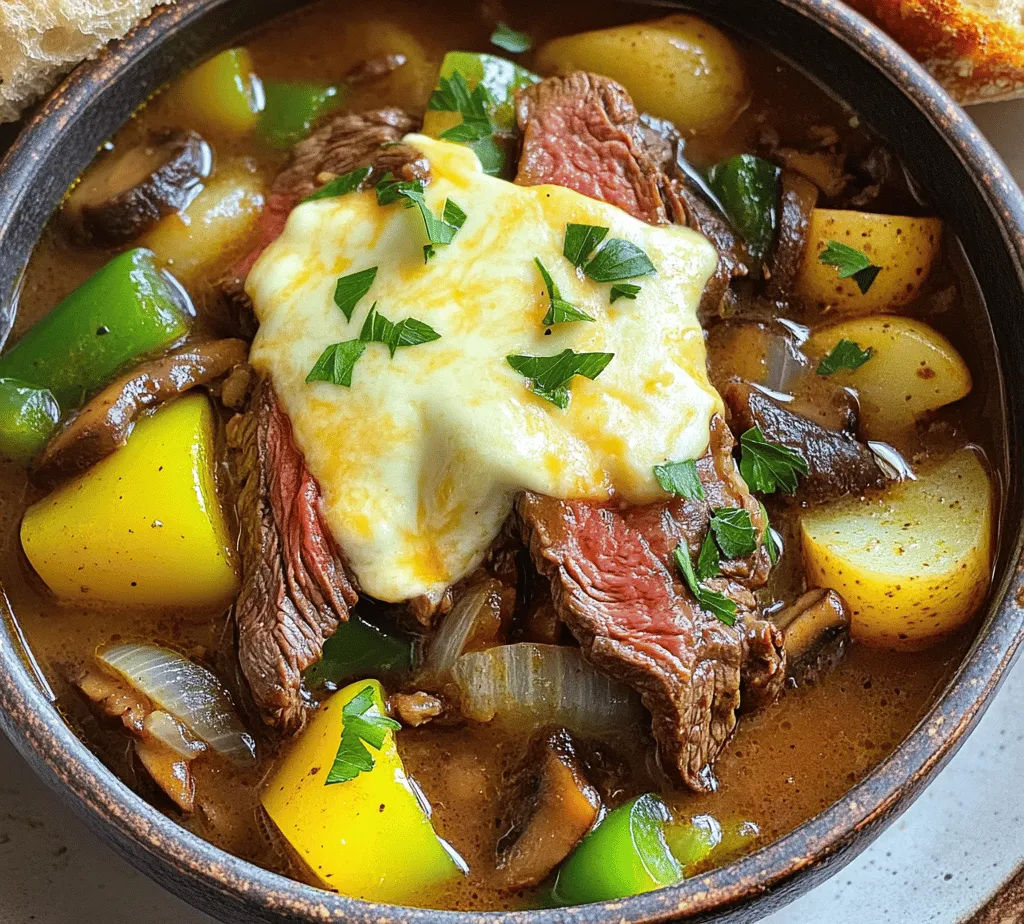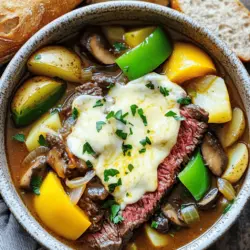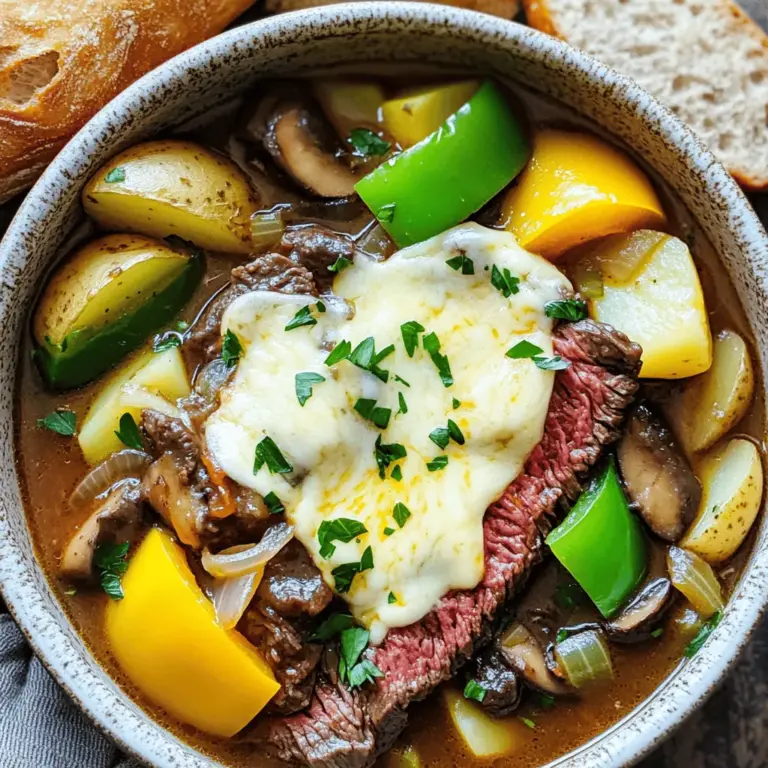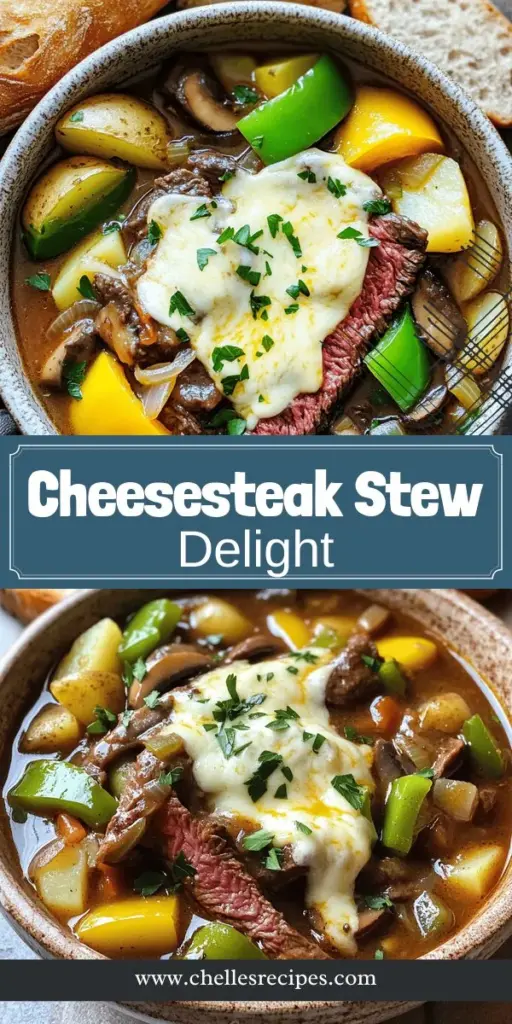Introduction
If you’re a fan of the iconic Philly cheesesteak, you’re in for a treat with this innovative and comforting Philly Cheesesteak Stew. This dish captures all the flavors of the beloved sandwich and transforms them into a hearty stew that’s perfect for cozy dinners at home. Originating in Philadelphia, the classic cheesesteak sandwich features thinly sliced beef, melted cheese, and sautéed onions and peppers, all served in a soft hoagie roll. The Philly Cheesesteak Stew takes these familiar ingredients and reimagines them into a warm and filling dish, ideal for those busy weeknight dinners or gatherings with friends and family.
With its rich flavors and satisfying texture, this stew not only pays homage to its sandwich predecessor but also stands out as a delicious meal that brings comfort on even the coldest of days. Whether you’re looking to warm up after a long day or impress guests at your next gathering, this stew is sure to be a hit.
The Allure of Comfort Food
Comfort food is defined by its ability to evoke feelings of warmth, nostalgia, and satisfaction. It’s the kind of food that wraps you in a blanket of flavors, making you feel at home no matter where you are. For many, comfort food is associated with family recipes passed down through generations, embodying memories of gatherings around the dinner table.
Stews, in particular, hold a special place in the hearts of those seeking comfort. They are often characterized by their rich, hearty textures and the way they warm you from the inside out. During colder months, a bubbling pot of stew can fill your home with inviting aromas and create an atmosphere of coziness. The beauty of stews lies in their versatility; they can be made with a variety of ingredients, allowing for endless adaptations while still delivering that classic comfort food experience.
The Philly Cheesesteak Stew is a modern adaptation of a classic dish that draws on the nostalgia of the original cheesesteak. It takes the components that have made the sandwich a favorite and combines them in a way that is both comforting and satisfying. As we delve into the ingredients and cooking process, you’ll see how each element contributes to the overall appeal of this dish.
Ingredients Breakdown
Creating a delicious Philly Cheesesteak Stew starts with selecting the right ingredients. Here’s a breakdown of the primary components that make this dish so special:
- Beef: The star of the show, traditionally, ribeye or sirloin steak is used for its tenderness and rich flavor. When cooked properly, it provides that signature cheesesteak taste that we all love. Choosing high-quality, fresh beef is crucial, as it enhances the overall flavor and texture of the stew.
- Cheese: No cheesesteak is complete without cheese! Provolone, American, or even Cheez Whiz can be used to achieve that creamy, melty goodness. The type of cheese you choose will influence the stew’s richness, so opt for one that you enjoy.
- Vegetables: Onions and bell peppers are classic additions, bringing sweetness and crunch to the dish. Fresh vegetables not only add flavor but also provide essential nutrients, making your stew healthier. The balance of textures from the sautéed vegetables complements the tender beef beautifully.
- Broth: A rich beef broth serves as the base of the stew, ensuring that every bite is packed with flavor. You can use homemade broth for a richer taste or store-bought for convenience.
- Seasonings: Simple seasonings like garlic powder, paprika, salt, and pepper allow the natural flavors of the ingredients to shine through, while also adding a bit of warmth and depth.
Using fresh, high-quality ingredients is vital to enhancing the flavors of your Philly Cheesesteak Stew. Each component plays a significant role in creating a dish that is not only hearty but also packed with nutritional benefits. The beef provides protein and iron, while the vegetables contribute vitamins and fiber, making this stew a wholesome choice for any family meal.
The Cooking Process
The cooking process for Philly Cheesesteak Stew is straightforward, but understanding each step is essential to achieving the best results. Here’s a step-by-step description to guide you through the preparation and cooking of this delicious dish:
Preparing the Beef
Start by selecting your beef cut. Thinly slice your ribeye or sirloin against the grain to ensure tenderness. For the best browning, allow the beef to come to room temperature before cooking. This helps in achieving that perfect sear.
In a large pot or Dutch oven, heat a tablespoon of oil over medium-high heat. Once the oil is shimmering, add the beef in batches, ensuring not to overcrowd the pot. This allows for even browning and prevents steaming. Cook the beef for 2-3 minutes on each side until it develops a nice crust, then remove it from the pot and set it aside.
Sautéing Vegetables
With the beef removed, it’s time to enhance the flavors of the stew by sautéing the vegetables. In the same pot, add another tablespoon of oil if needed, and toss in sliced onions and bell peppers. Sauté these vegetables over medium heat until they soften and caramelize, about 5-7 minutes. The goal is to extract the natural sugars from the onions, adding a sweet depth to the stew.
Feel free to add minced garlic towards the end of the cooking time to prevent it from burning. Garlic adds a fragrant element that complements the sweetness of the onions and peppers.
Building the Stew
Once the vegetables are beautifully sautéed, it’s time to build your stew. Return the browned beef to the pot and stir to combine with the vegetables. Next, pour in your beef broth, scraping the bottom of the pot to deglaze and incorporate any flavorful browned bits.
Add in your seasonings: garlic powder, paprika, salt, and pepper, adjusting according to your taste preferences. Bring the mixture to a boil, then reduce the heat to low and allow it to simmer for at least 30 minutes. This slow cooking process allows the flavors to meld together and the beef to become tender.
As the stew simmers, the aromas will fill your kitchen, inviting everyone to gather around for a hearty meal.
With these initial steps, you’re well on your way to creating a delicious Philly Cheesesteak Stew. As you continue through the cooking process, you’ll find that each ingredient plays a vital role in building depth of flavor, ultimately delivering a comforting dish that’s perfect for any occasion.
Stay tuned for the next part, where we’ll delve deeper into finishing touches, serving suggestions, and tips for getting the most out of this savory stew.

Simmering: The Importance of Patience in Developing a Rich Taste
When it comes to creating a flavorful Philly Cheesesteak Stew, simmering is an essential step that should never be rushed. During this phase, the ingredients meld together, allowing their flavors to deepen and intensify. After browning your beef and sautéing the vegetables, transfer everything into a pot with your chosen broth. Bring it to a gentle boil, then reduce the heat to low and let it simmer uncovered for at least 45 minutes to 1 hour.
This simmering time is crucial for two reasons. First, it allows the tough fibers in the beef to break down, resulting in tender, melt-in-your-mouth bites. Second, the longer the stew simmers, the more the flavors will intermingle, creating a rich, savory base that embodies the essence of a classic Philly cheesesteak. Consider this your “slow-cooking” moment; patience will reward you with a stew that bursts with flavor.
Final Touch: The Magic of Melted Provolone Cheese in the Stew
A Philly cheesesteak wouldn’t be complete without its signature cheese, and in this stew, provolone plays a starring role. As the stew nears completion, it’s time to add the final touch that elevates this dish to a whole new level. Just before serving, sprinkle a generous amount of shredded provolone cheese over the top of the stew. Cover the pot briefly to allow the cheese to melt seamlessly into the savory broth.
The result is a creamy, luscious finish that beautifully enhances the flavors of the beef and vegetables. The melted provolone creates a comforting richness that will have your taste buds dancing. For an added layer of flavor, consider mixing in a bit of grated Parmesan for a nutty twist.
Flavor Profile and Variations
Understanding the flavor profile of your Philly Cheesesteak Stew is key to mastering this dish. The base is a hearty blend of beefy richness, punctuated by the sweetness of caramelized onions, the vibrant crunch of bell peppers, and the creamy texture of melted provolone. This combination results in a stew that is both comforting and satisfying, perfect for a chilly evening.
Analysis of the Flavor Profile of the Stew
The stew’s flavor profile can be characterized by its umami depth from the beef and broth, balanced by the sweetness of the sautéed vegetables. The provolone cheese adds a creamy, slightly tangy finish that complements the savory elements beautifully. The overall taste is rich and hearty, embodying the classic Philly cheesesteak experience in a comforting stew form.
Discussion on Potential Variations and Substitutions
While the traditional version of Philly Cheesesteak Stew is delightful as is, there are several variations and substitutions you can explore. For instance, if you’re looking to lighten the dish, consider using lean ground beef or even ground turkey. This change will alter the texture slightly but can contribute to a healthier meal.
Another variation involves the addition of mushrooms, which can enhance the umami aspect of the stew. Simply sauté sliced mushrooms alongside the onions for an earthy flavor boost. If you’re feeling adventurous, try adding a splash of Worcestershire sauce or a dash of hot sauce for an extra kick.
Different Cuts of Beef and Their Impact on Texture and Taste
The type of beef you choose can significantly affect the stew’s overall texture and flavor. While flank steak is often the cut of choice for traditional cheesesteaks, using chuck roast or brisket in your stew will yield a more tender result after simmering. Chuck roast, with its marbling, breaks down beautifully during cooking, providing a rich flavor and a succulent texture.
Alternative Cheeses and Their Melting Properties
If provolone isn’t your cheese of choice, several alternatives can still deliver that gooey, melty goodness. Cheddar cheese offers a sharper flavor, while mozzarella provides a milder taste with excellent melting properties. For a gourmet touch, experiment with Gruyère or fontina cheese, which will add a nutty depth to the stew.
Adding Spices or Herbs for a Personalized Twist
To personalize your Philly Cheesesteak Stew, consider incorporating herbs and spices that resonate with your palate. Fresh thyme or rosemary can add an aromatic quality, while a sprinkle of dried oregano can enhance the overall flavor. For those who enjoy a bit of heat, adding crushed red pepper flakes or a dash of cayenne can elevate the dish further.
Serving Suggestions
When it comes to serving your Philly Cheesesteak Stew, presentation plays a key role in enhancing the dining experience.
Best Practices for Serving Philly Cheesesteak Stew
Serve your stew in deep, rustic bowls that highlight its hearty nature. Ladle the stew generously, ensuring each bowl is filled with tender beef, vibrant vegetables, and a luscious layer of melted cheese on top. For an added touch, garnish with freshly chopped parsley or scallions to provide a pop of color and freshness.
Presentation Ideas: Elevating the Dining Experience
To elevate the dining experience, consider serving your stew alongside crusty bread or garlic bread, perfect for soaking up the rich broth. You can also offer a side of crispy potato fries or a simple green salad to balance the meal. For a more elevated experience, pair the stew with a nice red wine, which complements the richness of the beef.
Suggested Side Dishes that Complement the Stew
While the stew is hearty enough to stand alone, a few side dishes can enhance your meal. Consider serving:
- Garlic Bread: Perfect for dipping into the stew.
- Coleslaw: A refreshing crunch balances the richness of the broth.
- Roasted Vegetables: Seasonal veggies provide a colorful and nutritious side.
- Potato Chips: For an unexpected crunch, serve with crispy potato chips on the side.
Nutritional Information
Understanding the nutritional value of your Philly Cheesesteak Stew is essential, especially if you’re mindful of your dietary choices.
Overview of the Nutrition Facts per Serving
A typical serving of Philly Cheesesteak Stew (approximately 1.5 cups) contains approximately:
- Calories: 350-400
- Protein: 30-35 grams
- Fat: 15-20 grams
- Carbohydrates: 30-35 grams
- Fiber: 3-4 grams
These values can fluctuate based on the specific ingredients used, such as the type of beef or cheese.
Discussion on Balancing Indulgence with Healthy Eating
While this stew is undeniably indulgent, it can be balanced with healthier choices. Opt for leaner cuts of meat and reduce the amount of cheese used to cut back on calories and fat. Additionally, incorporate more vegetables into the stew for added fiber and nutrients without significantly increasing the calorie count.
Tips for Modifying the Recipe to Fit Various Dietary Needs
If you’re catering to specific dietary needs, consider the following modifications:
- Gluten-Free: Use a gluten-free broth and ensure all seasonings are gluten-free.
- Low-Carb: Substitute potatoes with cauliflower for a lower-carb option.
- Dairy-Free: Choose dairy-free cheese alternatives or omit cheese altogether while adding more herbs and spices for flavor.
Conclusion
Philly Cheesesteak Stew is a delightful dish that brings the beloved flavors of a classic cheesesteak into a warm, comforting bowl. Its rich, savory profile and versatility make it an excellent choice for family dinners or cozy gatherings with friends. From the tender beef to the melty provolone, each bite is a reminder of why we cherish homemade meals.
We encourage you to try making this stew in your kitchen, experimenting with variations and substitutions that suit your taste preferences. Whether you stick to the traditional recipe or put your own spin on it, the joy of cooking and sharing meals with loved ones is what truly matters.
So gather your ingredients, embrace the simmering process, and indulge in the comforting warmth of this Philly Cheesesteak Stew. Your family and friends will surely appreciate the effort, and you might just find a new favorite in your culinary repertoire. Happy cooking!



